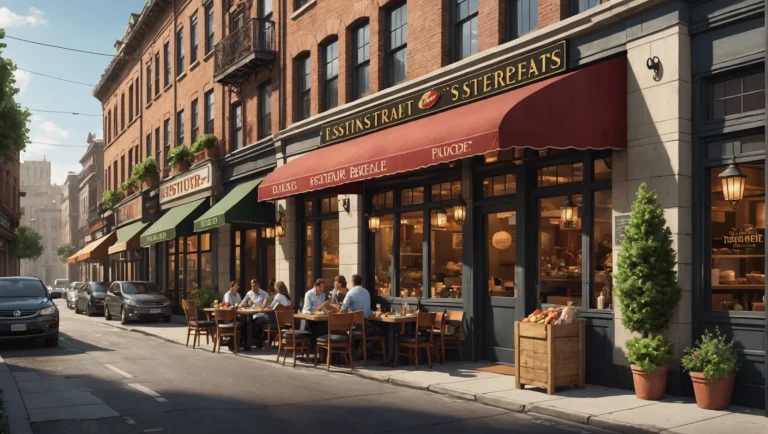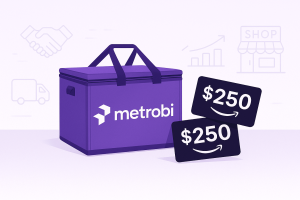Outsourcing your restaurant deliveries in 2024 is no longer a question of “if,” but rather “when” and “how.”
With the rapid growth of food and delivery apps and services and changing consumer preferences, restaurant owners who fail to adapt risk being left behind in an increasingly competitive market.
But here’s the good news: outsourcing delivery can be your secret weapon for success.
By partnering with the right delivery service, you can expand your reach, save costs, and focus on what you do best – creating delicious meals that keep customers coming back for more.
In this comprehensive guide, we’ll explore the benefits of outsourcing delivery, how to choose the perfect delivery partner, and the key strategies for managing and optimizing your outsourced delivery operations in 2024.
Outsourcing Restaurant Delivery Service
Restaurants that outsource delivery generate $121.29 in revenue per customer
Earn $1,200+/week delivering for local businesses
Driver benefits:
- Steady local business routes
- Weekly pay + tips
- Dedicated support team
- Flexible scheduling
The Benefits of Outsource Your Restaurant Deliveries in 2024
Over the past 12 months, the restaurant industry has seen a significant shift towards outsourcing delivery services. As the demand for food delivery continues to grow, many restaurant owners have recognized the benefits of partnering with a third party service.
Cost Savings and Efficiency
Outsourcing delivery can also lead to significant cost savings for restaurants. By eliminating the need to invest in delivery vehicles, maintenance, and hiring dedicated delivery staff, restaurants can reduce their overhead costs and focus on their core business activities. Metrobi specializes in optimizing distribution for catering businesses, ensuring efficient and reliable deliveries without the added strain on resources.
Having An Internal Delivery Team
Having an internal delivery team is more costly because they would have to hire riders, making outsourcing more cost-effective
Flexibility and Scalability
Another benefit of outsourcing delivery is the flexibility and scalability it provides. Restaurants can easily adjust their delivery capacity based on demand fluctuations.
The past year has shown that the ability to adapt quickly to changing market conditions is crucial for restaurants. By outsourcing delivery, restaurants can scale their operations without significant capital investment, allowing them to remain competitive in an evolving landscape.
Metrobi is transforming catering deliveries
Specialized solutions for catering businesses:
- Catering-trained drivers
- Proper handling equipment
- Peak day delivery support
- 23% average cost reduction
Choosing the Right Delivery Service Partner for Your Restaurant
Evaluating Delivery Service Providers and Third Party Delivery Companies
When selecting a delivery service partner for your restaurant, it’s crucial to conduct thorough research and compare the available options in your area. You can start by identifying the popular and reliable delivery service providers that operate within your restaurant’s vicinity. Evaluate each provider based on their commission rates, fees, and pricing structures to ensure they align with your restaurant’s financial goals and budget.
Next, assess the provider’s reputation, customer service, and driver network. Look for a partner with a proven track record of delivering high-quality service and maintaining a reliable fleet of drivers. Read reviews from other restaurant owners and customers to gauge their experiences and satisfaction levels with the delivery service provider.
Market share and customer base
Average delivery times and order accuracy
Driver training and performance metrics
Technology and integration capabilities
Customer support and issue resolution processes
Restaurants That Elect Third Party Deliveries
Restaurants that elect a third-party ordering and delivery service will pay fees, including commission fees
Negotiating Terms and Contracts
Before finalizing your partnership with a third party delivery company or service provider, carefully review and negotiate the terms and contracts. Pay close attention to the commission rates, payment terms, and any additional fees associated with the delivery services. After finalizing all discussions, you incorporate these points into the contract and complete the signing process using electronic signatures.
You can consider the duration of the contract, delivery fees and any minimum order volume requirements. Assess whether the terms provide flexibility for your restaurant to adjust or terminate the partnership if necessary. Additionally, you can discuss the liability and insurance coverage provided in house delivery service provider to protect your restaurant from potential risks or damages during the delivery process.
Seek clarity on the ownership and usage of customer data collected through the delivery platform. You can ensure that your restaurant retains access to valuable customer insights and has the ability to communicate with your customers for marketing and loyalty programs.
Managing Outsourced Delivery Operations Effectively
Integrating Delivery Orders with Your Restaurant’s POS System
Seamless integration between your restaurant’s point-of-sale (POS) system and the delivery provider’s platform is crucial for efficient order management. By connecting these systems, you can automatically transfer delivery orders from the provider’s app to your POS, reducing the risk of manual entry errors and saving valuable time.
-
Eliminate the need for manual order entry, minimizing errors and ensuring accuracy
-
Streamline kitchen operations by automatically sending delivery orders to the kitchen display system
-
Enable real-time tracking of delivery orders, from preparation to dispatch, for better coordination
To further optimize the integration process, consider investing in a POS system that offers robust API capabilities. This allows for more customization and flexibility in connecting with various third party delivery apps and platforms. Additionally, look for POS systems that provide detailed reporting and analytics on delivery orders, enabling you to make data-driven decisions to improve your delivery operations.
Communicating Effectively with Your Delivery Partner and Third Party Delivery Services
Building a strong, collaborative relationship with your delivery service provider is key to the success of your outsourced delivery operations. Establish clear communication channels and regularly provide feedback to address any concerns promptly.
Third Party Food Delivery Market
The third-party food delivery market is expected to reach $24.5 billion by 2022
Schedule regular check-ins with your delivery partner to discuss performance and identify areas for improvement
Use a shared communication platform, such as Slack or Microsoft Teams, for real-time updates and issue resolution
Provide constructive feedback on delivery times, driver behavior, and customer complaints
In addition to regular communication, consider working with your delivery partner to optimize delivery routes and times. By sharing data on popular delivery locations and peak order times, you can help your partner allocate resources more efficiently, resulting in faster delivery times and happier customers.
Food Delivery App
The number of food delivery app downloads is up 380%, compared to three years ago
Training Your Staff for Delivery Excellence
Proper staff training is essential for ensuring a smooth and efficient delivery process for online orders. You should educate your team on the importance of accuracy, timeliness, and customer service in the context of delivery orders.
Order accuracy: Emphasize the importance of double-checking orders before packaging and dispatch
Packaging techniques: Train staff on proper packaging methods to maintain food quality during transit
Delivery-specific customer service: Provide guidance on handling delivery-related customer inquiries and complaints
Regularly update your training materials to incorporate feedback from customers and delivery partners. You can consider implementing a delivery team-specific incentive program to motivate staff and recognize outstanding performance in handling delivery orders.
Measuring the Success of Your Outsourced Delivery Strategy
Key Performance Indicators (KPIs) to Track
To effectively measure the success of your outsourced delivery strategy, it’s crucial to establish and monitor key performance indicators (KPIs). These metrics will provide valuable insights into the performance of your delivery operations and help you identify areas for improvement.
Tracking the number of delivery orders and the corresponding revenue generated by delivery app is essential to gauge the overall success of your outsourced delivery strategy. By monitoring these metrics over time, you can identify trends, seasonal fluctuations, and the impact of promotional campaigns on your delivery sales.
The speed and accuracy of your deliveries directly impact customer satisfaction and loyalty. Work closely with your delivery partner to track metrics such as average delivery time, on-time delivery rates, and order accuracy. Set benchmarks and continuously strive to improve these metrics to ensure a high-quality delivery experience for your customers.
Continuously Monitor and Adapt Your Strategy
Measuring the success of your outsourced delivery strategy is an ongoing process. As the food delivery landscape evolves, it’s essential to continuously monitor your performance and adapt your strategy to stay competitive.
Set a schedule to review your KPIs and customer feedback on a regular basis, such as weekly or monthly. This will help you stay on top of any changes in performance or customer sentiment and allow you to quickly address any issues that arise.
Keep yourself informed about the latest trends, technologies, and best practices in the food delivery industry. You can attend industry events, read relevant publications, and engage with your delivery partner to stay up-to-date on new features and opportunities to improve your delivery operations.
As you gather more data and insights over time, be willing to make adjustments to your outsourced delivery strategy. This may involve changing your menu offerings, updating your packaging, or exploring new promotional strategies. By remaining flexible and data-driven, you can continuously optimize your delivery operations for success.
Adapting to the Evolving Food Delivery Landscape
Staying Updated with Industry Trends and Innovations
The food delivery industry is constantly evolving, with new technologies and innovations emerging regularly. To remain competitive, restaurant owners must stay informed about these developments and adapt their strategies accordingly.
One notable trend is the rise of ghost kitchens and virtual restaurants. Ghost kitchens are shared commercial kitchen spaces that allow multiple restaurants to prepare food for delivery without the need for a physical storefront. Virtual restaurants, on the other hand, operate solely online, offering a curated menu optimized for delivery. These models can help reduce overhead costs and expand a restaurant’s reach without significant investments in real estate.
Another important aspect is staying attuned to changing customer expectations and preferences. As the food delivery market matures, customers are seeking more personalized experiences, diverse menu options, and improved packaging solutions. By closely monitoring these trends and incorporating them into your delivery strategy, you can better meet the evolving needs of your target audience.
Continuously Improving Your Delivery Experience
To maintain a competitive edge in the food delivery market, it’s essential to continuously assess and improve your delivery experience. This process starts with regularly soliciting customer feedback through surveys, reviews, and direct communication. By actively listening to your customers, you can identify areas for improvement and make data-driven decisions to enhance your food delivery service.
Collaborating closely with your delivery partner is another key aspect of improving your delivery experience. Share customer feedback and insights with your partner, and work together to implement enhancements and optimize processes. This may involve refining packaging to ensure food quality, streamlining the online ordering process, or improving communication channels between your restaurant and the delivery partner.
Investing in staff training and development is also crucial for ensuring consistent delivery service quality. You can provide your team with the necessary skills and knowledge to handle delivery orders efficiently, maintain food safety standards, and provide excellent customer service. Regular training sessions and open communication with your staff can help foster a culture of continuous improvement and adaptability.
Understanding the Importance of Outsourcing Restaurant Delivery
The Competitive Advantage of Outsourcing Food Delivery Services
In today’s highly competitive restaurant industry, offering delivery services has become a necessity rather than a luxury. A survey by the National Restaurant Association found that 60% of restaurant operators believe that offering delivery has generated incremental sales. By outsourcing delivery to third-party providers, restaurants can gain a competitive edge and differentiate themselves from competitors who may not offer delivery. Are you pondering over integrating third-party food delivery services? Delve into the benefits and drawbacks of these prevalent solutions to ascertain if they align with your establishment’s strategic needs.
Outsourcing delivery allows restaurants to focus on their core operations, such as food preparation and customer service. By partnering with a third party delivery companies, restaurants can offload the logistics of delivery, including driver management, route optimization, and customer support. This enables restaurant staff to prioritize the quality of food and the in-house dining experience, which can lead to higher customer satisfaction and loyalty. Ultimately, Metrobi’s specialized catering delivery fulfillment solutions ensure that restaurants efficiently expand their reach without compromising on service or quality.
Third-party delivery platforms, such as Uber Eats, DoorDash, and Grubhub, have millions of users actively searching for food delivery options. By partnering with these platforms, restaurants can tap into a larger customer base and increase their visibility online. This can lead to increased brand awareness, new customer acquisition, and ultimately, revenue
Maintaining Quality and Brand Consistency
One of the main concerns restaurant owners have when outsourcing delivery is maintaining the quality and consistency of their food during transportation. However, by carefully selecting their own delivery drivers and partners and establishing clear guidelines and protocols, restaurants can ensure that their food arrives at customers’ doorsteps in the best possible condition. Metrobi assists catering businesses in addressing these challenges by offering delivery services across more than 20 U.S. cities, including providing same-day courier services in Seattle.
Investing in high-quality packaging materials and developing specific packaging guidelines for delivery orders can help maintain food quality during transit. This may include using insulated bags, separate containers for hot and cold items, and tamper-evident seals to ensure food safety. By prioritizing packaging and presentation, restaurants can create a positive delivery experience that reflects their brand and values.
Collaborating with delivery partners to provide training and establish open lines of communication can help ensure that delivery drivers understand and adhere to the restaurant’s quality standards. This may involve providing detailed instructions on handling and transporting food, as well as establishing a feedback loop to address any issues or concerns that arise.
By maintaining open communication and regularly monitoring delivery performance, restaurants can identify areas for improvement and make necessary adjustments to their delivery operations
Scalability and Cost-Effectiveness
Outsourcing delivery services can provide restaurants with the scalability and cost-effectiveness needed to grow their business. By partnering with third-party delivery providers, restaurants can avoid the upfront costs associated with building and maintaining their own delivery infrastructure, such as purchasing vehicles, hiring drivers, and developing logistics software.
Third-party delivery platforms offer restaurants the flexibility to scale their delivery operations up or down based on demand. During peak hours or busy seasons, restaurants can rely on the third party delivery service provider’s network of drivers to handle increased order volumes without having to invest in additional staff or resources. This flexibility allows restaurants to adapt to changing market conditions and customer demands more easily.
Outsourcing delivery can also help restaurants reduce labor costs associated with hiring and managing in-house delivery staff. By leveraging the delivery provider’s driver network, restaurants can save on expenses such as wages, benefits, and training. This can be particularly beneficial for smaller restaurants or those with limited resources, as it allows them to offer delivery services without incurring significant additional costs.
Outsourcing Restaurant Delivery
Restaurants that manage their own delivery generate $184.18 in revenue per customer
Embracing the Future of Restaurant Delivery
As the food delivery landscape continues to evolve, outsourcing your restaurant’s delivery services is a strategic move that can propel your business to new heights. By partnering with a reliable delivery provider, you can expand your reach, save costs, and focus on what you do best: creating delicious meals for your customers. Metrobi offers delivery services across over 20 US cities, featuring courier services in Miami, to support catering businesses in enhancing their operations efficiently.
Choosing the right delivery partner, managing operations effectively, and measuring your success are key to thriving in this competitive market. Stay informed about industry trends, continuously improve your delivery experience, and adapt to changing customer preferences to stay ahead of the curve.
Are you ready to take your restaurant’s delivery game to the next level? Start by evaluating potential delivery partners and developing a comprehensive strategy that aligns with your brand and values. With the right approach and a commitment to excellence, you can successfully navigate the exciting world of outsourced restaurant delivery in 2024 and beyond.














